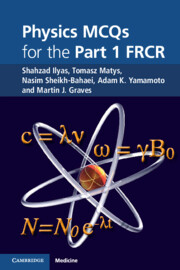Book contents
- Frontmatter
- Contents
- Preface
- Acknowledgements
- 1 Basic physics
- 2 Radiation hazards and protection
- 3 Imaging with X-rays
- 4 Film-screen radiography
- 5 Digital radiography
- 6 Fluoroscopy and mammography
- 7 Nuclear medicine
- 8 Computed tomography
- 9 Imaging with ultrasound
- 10 Magnetic resonance imaging
- Bibliography
- Index
1 - Basic physics
Published online by Cambridge University Press: 05 July 2011
- Frontmatter
- Contents
- Preface
- Acknowledgements
- 1 Basic physics
- 2 Radiation hazards and protection
- 3 Imaging with X-rays
- 4 Film-screen radiography
- 5 Digital radiography
- 6 Fluoroscopy and mammography
- 7 Nuclear medicine
- 8 Computed tomography
- 9 Imaging with ultrasound
- 10 Magnetic resonance imaging
- Bibliography
- Index
Summary
Which of the following statements regarding protons are correct?
They have a negative charge
They are equal to the number of electrons in a non-ionized atom
They are equal to the atomic number in a non-ionized atom
They have no mass
They increase in number relative to neutrons, following electron capture
The binding energy of electrons:
Is the energy expended in moving an electron from an inner to an outer shell
Is higher for an L-shell electron than an M-shell electron
Is influenced by the number of neutrons within an atom
Determines Bremsstrahlung photon energy
Determines the energy of the photoelectron produced following photoelectric absorption
Which of the following are correct regarding electromagnetic radiation?
Gamma rays are a form of electromagnetic radiation
The particles have a mass equivalent to that of neutrons
In a vacuum, the velocity of the particles differs depending on their individual properties
It results in a sinusoidal graph when magnetic field strength is plotted against time
The frequency is the interval between two successive crests
Regarding electromagnetic beam radiation:
Energy fluence is the number of photons per unit area of a beam
Beam intensity is the total amount of energy per unit area travelling per unit time
Wavelength is inversely proportional to frequency
Frequency is inversely proportional to photon energy (keV)
[…]
- Type
- Chapter
- Information
- Physics MCQs for the Part 1 FRCR , pp. 1 - 14Publisher: Cambridge University PressPrint publication year: 2011



